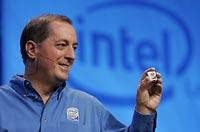Intel Core 2 Duo a big leap in chip race

Intel kicked its corporate-turnaround plan into high gear last week with the launch of its long-awaited Core 2 Duo, a line of computer chips that boast up to 40 percent more processing power while using 40 percent less electricity than the company's previous chips.
The Core 2 Duo, so named because it squeezes two computing brains onto a single microprocessor, allows the world's largest chip maker to leapfrog past its archrival, Advanced Micro Devices, in the race to give customers better chips to run computer servers and desktop and laptop computers.
Industry analysts said the new chips showed Intel still has competitive juice in computer-chip design.
"They are back," said Nathan Brookwood, principal analyst at Insight 64 in Saratoga, Calif. "For the last 18 months, Intel as a formidable competitor has sort of waned. They just didn't have the product lineup that they needed to compete with AMD's product on a feature or performance or power basis."
AMD has been leader
While Intel dwarfs AMD in corporate size, AMD has taken the lead in recent years in chip design. Since launching its first dual-core Opteron chip in 2003, AMD has gained 10 percentage points of market share based on revenue, growing from 7.5 percent of the market in the second quarter of 2003 to 17 percent in the first quarter of 2006, according to Insight64.
The Core 2 Duo is Intel's most important product launch since 2000, when it rolled out the Pentium 4 chips.
"This does not change the situation that AMD will continue as a formidable competitor, but now AMD will be facing a formidable competitor," Brookwood said. "The empire has struck back."
Prices for desktop Core 2 Duo chips range from $183 to $999. Prices for laptop chips haven't been announced.
Consumers will see desktop computers carrying the new Core 2 Duo chips on store shelves starting next week. Hewlett-Packard will offer the Core 2 Duo in its two higher-end consumer desktop products, including the $899 media center edition PC.
With the Core 2 Duo punching up the power in HP's media center, "you can stream high-definition video from your PC to your television," said Sean Paterson, an HP desktop product manager. And while a child is watching a movie in the living room, a parent sitting in the home office can edit a video running on the same PC while a virus scan runs in the background.
For bigger corporate computers, the Core 2 Duo's ability to conserve power will save money and headaches.
Corporate data centers — which are filled with racks of the computer servers that deliver Web sites, handle transactions and house data — eat up a lot of electricity cooling the equipment to prevent overheating. If a business's data center goes down because it can't cope with the rising temperature, or if it falls victim to rolling blackouts, "it can be crippling," said Colette LaForce, vice president of marketing for Rackable Systems, a Milpitas-based company that's introducing a Core 2 Duo computer server.
Faster-processing sought
And die-hard video game players crave faster processing power, which reduces the lag time between when gamers hit a keyboard button and can see the result on the screen. They demonstrated the chip's capability at the launch event Thursday at Intel headquarters in Santa Clara, Calif.
"You end up getting killed because you can't see what's going on," said Morgan Romine, a professional gamer.
Graphics-chip maker Nvidia then stole the stage to demonstrate the movielike quality video gamers will soon be able to immerse themselves in using Nvidia chips working with the Core 2 Duo-powered PCs.
But, in sign of how competitive the chip industry remains, Nvidia competitor ATI Technologies said Intel rescinded an invitation to appear at the event after the Canadian company announced earlier last week that it agreed to be acquired by Intel's rival, AMD.
Intel spokesman Robert Manetta said no one from ATI was ever scheduled to attend. But he added, "We did make a decision on Tuesday after the purchase was announced that it didn't seem appropriate for a system with an ATI component to be on stage."
Sean Maloney, Intel's executive vice president and chief sales and marketing officer, said the launch was "a big day" for Intel, a celebration on par with a birthday plus a wedding.